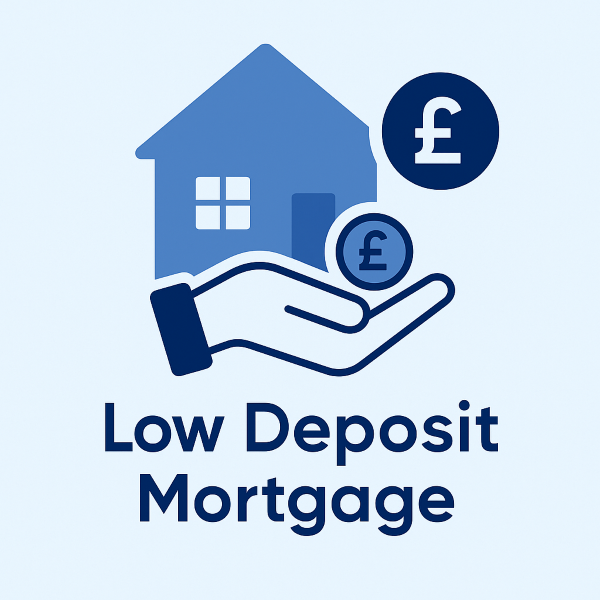A low deposit mortgage allows you to secure a home loan with a deposit of 5% or less of the property’s value. This results in a high loan-to-value (LTV) ratio, as you are borrowing most of the purchase price.
Many first-time buyers choose this option to enter the property market sooner. However, it is essential to consider the benefits and risks before proceeding.

The Benefits of a Low Deposit Mortgage
A key advantage of a low deposit mortgage is the ability to buy a property sooner. Saving for a large deposit can take years, particularly with rising living costs. A smaller deposit speeds up the homeownership process.
Key Benefits:
You can buy a property sooner rather than waiting to save a larger deposit.
A smaller deposit means you do not need to save as much upfront.
Some government schemes, such as the Mortgage Guarantee Scheme, help make low deposit mortgages more accessible.
It is an option for those with stable incomes but limited savings.
While a low deposit mortgage has advantages, there are risks involved. A major concern is negative equity, which occurs when the mortgage debt exceeds the property’s value.


Example of Negative Equity:
You buy a home for £200,000 with a 5% deposit.
Your mortgage is £190,000.
Property prices drop, and your home is now worth £180,000.
You owe more than the value of your home.
Negative equity can make it difficult to remortgage or move home. Lenders may also offer fewer deals to borrowers with high LTV mortgages.
Additional Risks:
Higher interest rates due to increased lender risk.
Limited mortgage product availability after the fixed term.
Property market fluctuations affect your home’s value.
Are Interest Rates Higher for Low Deposit Mortgages?
Interest rates are generally higher for low deposit mortgages. Lenders charge more to offset the risk of lending a large sum compared to the property’s value.
Borrowers with a higher deposit usually receive better mortgage deals with lower interest rates.
A 5% deposit mortgage, for example, may have an interest rate of around 6%, while a 25% deposit mortgage might secure a rate closer to 4%.*
Ways to Reduce the Risks of a Low Deposit Mortgage
There are several strategies to help manage the risks of a low deposit mortgage:
Overpaying on Your Mortgage: Extra payments can reduce the loan amount and minimise the impact of negative equity. Check your mortgage agreement for overpayment limits to avoid penalties.
Improving Your Property: Renovating your home can add value, helping to counteract market fluctuations.
Monitoring Property Prices: Staying informed about local property values can help you make better financial decisions.
Exploring Government Schemes: First-time buyers can check government-backed options, such as the First Homes scheme, which offers discounted homes to eligible buyers.
Alternative Options for First-Time Buyers
If a low deposit mortgage seems too risky, consider other routes:
Shared Ownership: You buy a share of a property and pay rent on the remainder.
Help from Family: Some lenders offer family-assisted mortgages, where a relative provides security or a cash contribution.
Saving for a Larger Deposit: Waiting longer to save more could secure you a better mortgage deal with lower interest rates.
Key takeaway
A low deposit mortgage is a practical solution for many buyers, especially first-time homeowners. However, understanding both the benefits and risks is crucial. Higher interest rates and negative equity are potential challenges; however, careful planning can help mitigate their impact.
If you are considering a low-deposit mortgage, speaking with a mortgage advisor may be beneficial. Check out our previous guide on buy-to-let.
People who found this page helpful also explored these related topics
FAQ: Low Deposit Mortgage
| Question | Answer |
|---|---|
| What is a low deposit mortgage? | A low deposit mortgage allows you to buy a property with a smaller upfront deposit, typically between 5% and 10% of the property value. The remaining balance is covered by your mortgage lender. |
| Who can apply for a low deposit mortgage? | First-time buyers, home movers, and those with limited savings may qualify. Lenders assess eligibility based on credit score, income stability, and affordability checks. |
| Are low deposit mortgages riskier? | They can be slightly higher risk because you borrow a larger percentage of your property’s value. Lenders may charge higher interest rates or require additional checks. |
| What schemes can help with a low deposit mortgage? | UK government options such as Shared Ownership and the First Homes Scheme can make it easier to buy with a small deposit. Some lenders also offer 95% LTV deals. |
| Do I need a guarantor for a low deposit mortgage? | Not always. Some lenders offer standard 95% mortgages, while others provide family-assisted or guarantor mortgages where a relative supports your application. |
| What credit score do I need for a low deposit mortgage? | A good credit score increases your chances, but some specialist lenders accept applicants with limited or fair credit if affordability and income are strong. |
| Can I get a low deposit mortgage with bad credit? | It’s possible, but expect higher rates or stricter conditions. Working with a specialist mortgage adviser can help you find the right lender for your circumstances. |
| How do I improve my chances of being approved? | Pay down existing debts, maintain regular savings, check your credit report for errors, and avoid new credit applications before applying. |
| Can I use a low deposit mortgage for a new-build home? | Some lenders offer new-build-friendly low deposit options, but they often require a slightly larger deposit or stricter affordability criteria. |
| How can Connect Experts help me? | Connect Experts matches you with qualified advisers who specialise in low deposit and first-time buyer mortgages across the UK. They help you compare lenders and secure a deal suited to your budget. |
